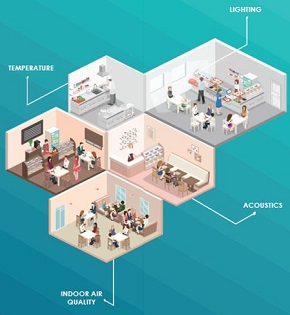BS ISO 17772 - Indoor environmental quality
The main objective of building services engineers and anyone involved in designing a built environment is to create a space conducive to the function of the building. Too often this gets lost in the plethora of other requirements; regulatory, economic and aesthetic.
At BSRIA, we see specifications in which the design parameters are not clearly defined and this frequently leads to gaps between expectation and performance and doubts about whether the completed building meets the client’s requirements. Some specifications indicate winter or summer temperatures, with no mention of tolerances or where the temperatures must be measured.
There are hundreds of useful standards, guides and codes of practice to every aspect of the built environment and of course, BSRIA contributes to this array of publications. But some buildings don’t warrant all the detail from these publications and a basic specification is better than no specification.
A new standard published in January 2018 aims to bring together the key requirements for Indoor Environmental Quality (IEQ) - BS ISO 17772-1:2017 'Energy performance of buildings. Indoor environmental quality. Indoor environmental input parameters for the design and assessment of energy performance of buildings'.
The standard specifies requirements for indoor environmental parameters: temperature, indoor air quality, lighting and acoustics and specifies how to establish these parameters for environmental design. It was drafted to provide a common basis for energy performance calculations but it has wider application as a basic standard for IEQ.
This standard is applicable where the criteria for indoor environment are set for human occupancy and where the production or process does not have a major impact on indoor environment. It includes design criteria for the local thermal comfort factors, draught, radiant temperature asymmetry, vertical air temperature differences and floor surface temperature. It also specifies occupancy schedules to be used in standard energy calculations and how different categories of criteria for the indoor environment can be used.
The criteria in this standard can also be used in national energy calculation methods. It sets criteria for the indoor environment based on existing standards and reports.
It does not specify design methods, but gives input parameters to the design of building envelope, heating, cooling, ventilation and lighting.
The standard defines four levels of IEQ:
- IEQi: High level of expectation and also recommended for spaces occupied by very sensitive and fragile persons with special requirements like some disabilities, sick, very young children and elderly persons, to increase accessibility.
- IEQii: Normal level of expectation.
- IEQiii: An acceptable, moderate level of expectation.
- IEQiv: Low level of expectation. This category should only be accepted for a limited part of the year.
The format of the standard is that the user should define the level of performance required for each parameter, to this end it provides forms to be completed by the user in Annexes A to F. However, in Annexes H to L it provides ‘default values’ for the parameters entered on the same forms and these are likely to be widely used.
Temperature is specified as the ‘Operative temperature’ effectively the mean of air temperature and radiant temperature at the building user’s location in most environments, where the air speed is under 0.2 m/s. Adaptive temperature, the user-acceptable temperature modified by the external temperature over the past seven days, is also recognised as relevant for spaces without mechanical cooling.
This article was originally published here by BSRIA in January 2018. It was written by Colin Pearson, Team Leader, BSRIA Sustainable Construction Group.
--BSRIA
[edit] Related articles on Designing Buildings Wiki
Featured articles and news
Infrastructure that connect the physical and digital domains.
Harnessing robotics and AI in challenging environments
The key to nuclear decommissioning and fusion engineering.
BSRIA announces Lisa Ashworth as new CEO
Tasked with furthering BSRIA’s impressive growth ambitions.
Public buildings get half a million energy efficiency boost
£557 million to switch to cleaner heating and save on energy.
CIOB launches pre-election manifesto
Outlining potential future policies for the next government.
Grenfell Tower Inquiry announcement
Phase 2 hearings come to a close and the final report due in September.
Progress from Parts L, F and O: A whitepaper, one year on.
A replicated study to understand the opinion of practitioners.
ECA announces new president 2024
Electrical engineer and business leader Stuart Smith.
A distinct type of countryside that should be celebrated.
Should Part O be extended to existing buildings?
EAC brands heatwave adaptation a missed opportunity.
Definition of Statutory in workplace and facilities management
Established by IWFM, BESA, CIBSE and BSRIA.
Tackling the transition from traditional heating systems
59% lack the necessary information and confidence to switch.
The general election and the construction industry
As PM, Rishi Sunak announces July 4 date for an election.
Eco apprenticeships continue help grow green workforce
A year after being recognised at the King's coronation.
Permitted development rights for agricultural buildings
The changes coming into effect as of May 21, 2024.























